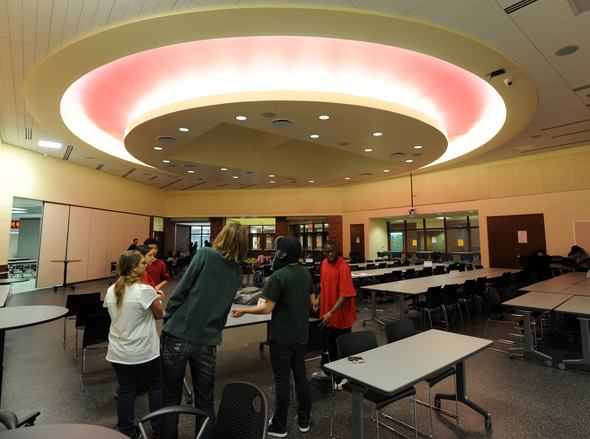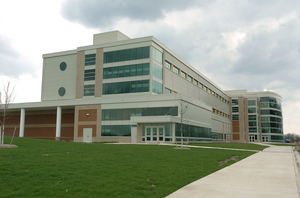Ann Arbor school district celebrates end of $255M bond project that helped modernize buildings

The interior of Pioneer High School's renovated cafeteria was one of the last projects to be completed under the 2004 school bond project.
Lon Horwedel | AnnArbor.com
Note: This story has been corrected to give the correct date of the open house celebration
Six years after a voter-approved bond, construction and upgrades are finally finished at Ann Arbor Public Schools.
And officials say the projects have thrust the district into the 21st century.
In June 2004, voters approved a $255 million bond that was used to build Skyline High School, create new preschool facilities, make technological upgrades in nearly every school and make infrastructure improvements to every school.
Randy Trent, the district's executive director of physical properties, said the process of using the bond money for construction started off slowly and was marred by some “stumbling blocks.” But it ended on a positive note, he said.
“We had our problems at the beginning as Skyline got started, but as it started to progress and we got (former superintendent Todd) Roberts on board … we improved every step of the way,” he said.
Skyline and several other projects originally came in over budget and were delayed. But as the projects in the Comprehensive School Improvement Plan were completed, the district was able to realize unexpected savings, Trent said.
That allowed for more technological upgrades than planned, in addition to new projects. The plan originally called for about $20 million in technological purchases, but about $7 million will be added.
The bond project, first targeted to be complete by the fall of 2009, was finished this fall with the final original construction project — renovations in Pioneer High School.
The district is holding a celebration of the completion Friday at 6:30 p.m. in the Pioneer cafeteria.
Saving money to do more
By having the majority of the work done during the school year — as opposed to the more expensive summer period — the district was able to realize a 15 percent to 20 percent savings on many projects, Trent said. The downturn in the economy also helped drive down bidding prices in recent years.
“At Slauson, they had a lot of intensive work done during the school year, which allowed for a lot of money to add a media center renovation that wasn’t even in the plan,” he said. “Same thing at Clague — the main office hadn’t ever been renovated, so we had that done.”
Some projects in the plan weren't done at all, allowing the district to save bond money.
In the original plan, seven new preschool facilities were to be built. But as the new facilities were being constructed, the district realized there wasn't enough demand to fill them, and four buildings were scrapped. Money meant for those projects was used for new technological purchases, Trent said.
After finishing many of the infrastructure upgrades — including new boilers, floors and vents in many schools — Trent said the district was able to go back to the buildings and ask what other improvements could be made.
“When the opportunities became available, we went back to the buildings to see what they thought are the needs,” he said. “What are the things that will make your life even better? That’s where I think we got a lot of the benefit.”
A more modern learning environment
Teachers are embracing the technological upgrades, said Scarlett Middle School Principal Gerald Vazquez.
Scarlett was one of the schools enhanced the most by the bond money, singled out for a technology infusion.
“There are teachers who utilize those tools on a daily basis,” he said. “There’s an opportunity to improve communication with students. It’s a powerful tool because if a kid is out of school one day and the teacher is utilizing Google Docs and updating their calendar, the kid can see what transpired in their classroom.”
Some of the initiatives originally planned, such as a 1-to-1 ratio of laptops and students, fell through during the bond process, Vazquez said.
In addition to the technological upgrades, Scarlett also had the facade of the building renovated and other structural changes made within the school.
Vazquez said parents and staff have told him the school looks more welcoming now and inspires a greater sense of pride.
“It’s something you can be proud of,” he said. “It’s more inviting where kids feel comfortable in a solid learning environment.”
Spacious high schools

Skyline High School was paid for with money from the bond
Lon Horwedel | AnnArbor.com
In the days before Skyline High School, district spokeswoman Liz Margolis would take groups of community members to Huron and Pioneer high schools to allow them to experience the crush of passing time.
“We’d take them to the schools and we had them stand as best they could off to the side during passing time, and they were shocked,” she said. “It was an amazing experience to see the waves (of students) filter through the halls.”
However, with all three high schools one year away from settling in at a student population of about 1,600 at each school, those days are gone.
Margolis said she’s heard comments, mostly from staff, about how different the schools are now that the student population has decreased. At its peak of about 3,000 students, Pioneer had the largest high school student body in the state.
It would be a striking change to former students, she said.
“If a student that graduated a couple years ago stood in the hall during passing time they would say, ‘Oh my God,’” she said. “It’s quite dramatic.”
Kyle Feldscher cover K-12 education for AnnArbor.com. He can be reached at kylefeldscher@annarbor.com.


Comments
Dr. I. Emsayin
Sat, Dec 11, 2010 : 9:10 a.m.
It was always in the fine print that the number of students in the high schools would be smaller (with the addition of Skyline) but the number in the classrooms would remain the same or increase (due to losing teachers to Skyline and being able to offer fewer courses). I don't think the high schools cater to the elite students as there seem to be many initiatives to increase achievement for all students, but it is all about academic achievement and state standards, not about vocational education. Students don't have time in their schedules to take the vocational programs they may like because the state standards have been drastically increased, especially for the students who used to complete high school with two years of math and now need 4 years of math. Probably the way math is delivered could be improved to accommodate many who will struggle with the 4th year of math, but that will take time to work out as the state gets used to the new standards.
limmy
Sat, Dec 4, 2010 : 11:35 a.m.
Yes, my kids are in classes with 35 students. It is terrible. What really irritates me is that AAPS buses students from Slauson and Tappan for their very own advanced math class at Pioneer with 16 kids in the class. Meanwhile the students that actually are in high school math have 30+ students in their classes. Make no mistake where the priorities are in this district. Always has been and always will be the elite students.
sh1
Sat, Dec 4, 2010 : 10:54 a.m.
And why was there not enough money to finish the job at the elementary buildings?
a2edu
Sat, Dec 4, 2010 : 9:46 a.m.
Here's a question that no one seems to be asking: Why are class sizes at Pioneer larger than ever??? Who cares if you can walk through less crowded halls if you have 36 kids in each English class? It should be about what happens in the class room... NOT what the halls and cafeteria ceilings look like.
shepard145
Thu, Dec 2, 2010 : 6:38 p.m.
Is that ceiling an example of how they spent $225 million dollars of Ann Arbor resident's money?
PhillyCheeseSteak
Thu, Dec 2, 2010 : 6:02 p.m.
limmy & ViSHa - I too have wondered about the decision to move Rec & Ed's offices into Pioneer H.S. How was Pioneer chosen? Why not one of the middle schools that are HUNDREDS of student below capacity? If it had to be Pioneer, why not use a portable for Rec & Ed? And then I question why Pioneer removed the vocational rooms from the school in the first place and converted them into "traditional" classrooms? Is it because administrators think ALL Pioneer students are going on to college? There are hardly any vocational programs left at Pioneer, which is short-sighted and a shame because not everyone is cut out for a university education. Our diverse economy needs mechanics, hospitality industry jobs, hair stylists, etc.
ViSHa
Thu, Dec 2, 2010 : 10:32 a.m.
Those Pioneer portables are a disgrace! For a city that comes in 2nd in the top 25 smartest cities, it should be an embarrassment that something hasn't been done (well i guess something was done, but as noted, they gave that space to rec. ed.)
MjC
Thu, Dec 2, 2010 : 9:03 a.m.
I served as a parent rep on one of the committees at Huron High School overseeing the use of these funds. They were well spent at Huron. Educating our K-12 students should be a number one priority in this college town of ours. Providing students with a modern, safe, clean school environment promotes learning. I'd have no problem voting for another bond for this purpose. We need to provide the best teachers, staff, technology and school environment for ALL our kids.
DonBee
Thu, Dec 2, 2010 : 8:19 a.m.
Lets see we will be 3 to 5 year computers and then spend 20 years paying for them. Sounds wonderful, even better than buying 10 year buses with a 20 year mortgage.
limmy
Thu, Dec 2, 2010 : 8:02 a.m.
Now, if they would only get rid of the portable classrooms at Pioneer and renovate the ancient theater (new seats anyone?). An entire wing of the building was renovated and turned over to Rec Ed while students continue to trudge through the outdoors in all kinds of weather to the portables. I have heard that the new ones they have now don't even have bathrooms.
sh1
Thu, Dec 2, 2010 : 7:31 a.m.
I'm surprised to read this. Many schools were told the money had run out and did not get the planned upgrades.
AlphaAlpha
Thu, Dec 2, 2010 : 7:03 a.m.
Nice. It would be interesting to hear Mr. Trent's plan for proper maintenance of these beautiful new structures; with proper care, they should last hundreds of years.